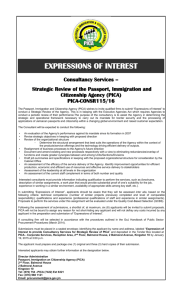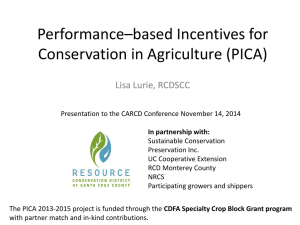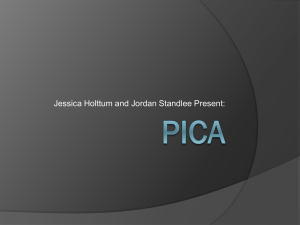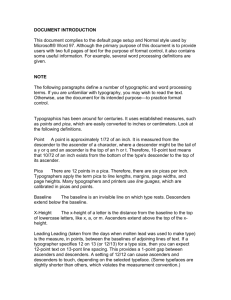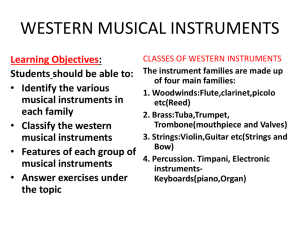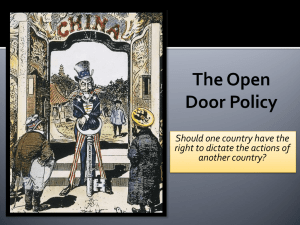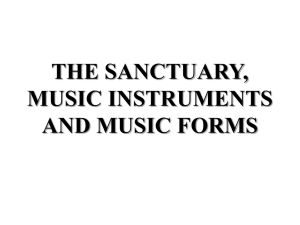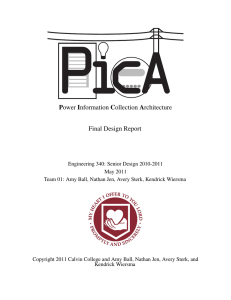Latin American Music - Missouri State University
advertisement
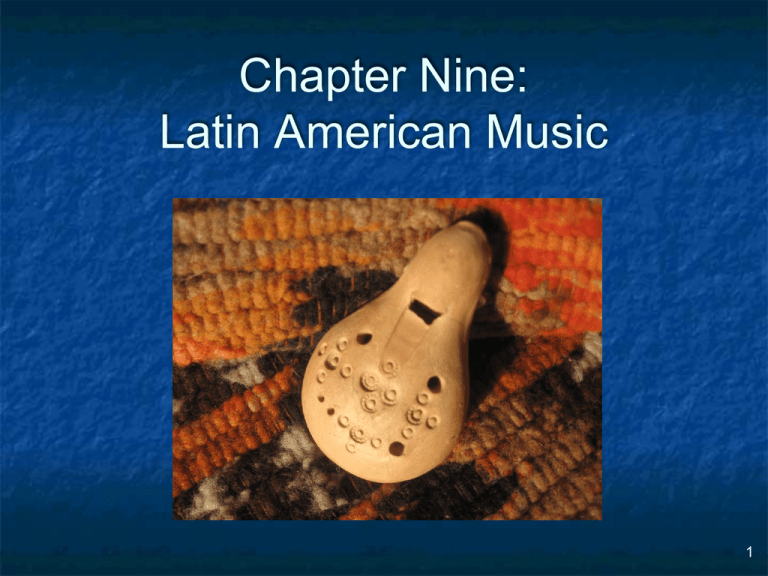
Chapter Nine: Latin American Music 1 Four Major Categories of Latin American Music Indigenous Music Iberian (Spanish/Portuguese) and mestizo (mixed ancestry) Folk Music African influenced Music Urban Popular Music 2 Indigenous Peoples Mexico and Central America: Aztec, Maya, and Inca. South America, over 100 languages and 2000 dialects. Several conquests over the past 500 years, Spanish or Portuguese; genocide of much indigenous population, early 16th century 3 Instruments Indigenous instruments Flutes (kenas), ocarinas, conches, panpipes (zampoñas), and various percussion instruments (see the Sue Reichling presentation, class 36) Non-indigenous (imported) instruments String instruments, related to violin, harp, and guitar 4 South America Andes Mountain Region 5 Andes Village Musicians, featuring panpipes & drums 6 Panpipes with Kena, Ozark Empire Fair 7 Two Against Three Where have we seen this before? Sesquialtera (simultaneous division of the measure by 3 and by 2) Hemiola (3 in the space of 2) IV:7 “Pajarillo” European Renaissance music Brahms 8 Nueva Canción Nueva Cancion originated in Chile as a modern and socially conscious musical style and message that draws attention to the struggles for dignity by everyday people. “El Lazo” (IV:8) Pica Pica, by a composer from Springfield’s sister city in Mexico, Tlaquepaque, is not so political in tone. Sesquialtera = simultaneous feeling of 6/8 and 3/4 meters (two against three). “America” from West Side Story alternates 6/8 and 3/4 9 Pica, Pica Abran muy bien sus ojitos, Agradezco su atencion Con el degido respeto Voy a entonar me cancion. Open your eyes very wide, I am grateful for your attention With due respect I am going to sing my song. Identedad de mi pueblo, Clutivo de mis ancestros, Yo les presento un amigo, Por favor tomen su asiento. Intentity of my people, Cultivation of my ancestors, I introduce you to a friend, Please take your seats. Con el maiz y el frijol, Plantas hermanas del sol, El chile es tan mexicano, Como el mariachi y su son. With the corn and the bean, Sister plants of the sun, The Chile is so Mexican, Like the mariachi and its rhythm Pica, Pica, Dale a tu vida sabor, Hot, Hot, give flavor to your life Pica, pica, Milagro de esta region; Hot, Hot, miracle of this region; Pica, pica, Travieso y vcilador,Hot, Hot, mischievous and playful, Pica, pica, Alburero y trovador. Magician and troubadour. 10 No tengan miedo senores, Esto es cuestion de semblanza, Aqui la cosa es calmada, Pueden agarrar confianza. Have no fear people, This is a question of similarities. Here, things are calm, You can trust. Hay ena gran variedad, Hay diferentes sabores, De formas y de colores, Como podran apreciar. There is a great variety, There are different flavors Of shapes and colors As you will be able to appreciate. Hay mulato y hay serrano, Y entre otros el cascabel, Y uno que se cree muy ancho, A ver quien puede con el. There are dark ones and others from the mountain. And among other the bell, And one that thinks himself very wide. Let’s see who can put up with him. Chorus 11 El guero le dijo al gordo, Por ahi viene el jalapeno Anda buscando camorra, Junto con el cuaresmeno. The blond said to the fat one There comes the jalaapeno. He’s looking for trouble, Together with the one who is the lesser. El manzano es muy tranquilo, No seas guajillo le dicen, The banana is pretty calm. They say to him, “Don’t be a hillbilly, Si ya te quieres ir, vete, Porque ahi viene el molcajete. If you want to go, leave, Because there comes the troublemaker.” "me agarran desprevenido,” Grito el chipotle maldito Y el piquin que le responde, “They catch me unprepared,” Shouted the cursed chile chipotle. And the little hot chili responded, "a mi me pelan fresquito” Chorus “They skin me raw.” Translation by Steve Breedlove 12 Bolivian K’antu h “Kutirimunapaq” (CD IV:9) “Hocketing panpipes, with rhythmic melodies played in parallel fifths and octaves and a strong, steady rhythm on a large drum.” Instruments including multiple (over 20!) zampoña, wankara drum, and ch’inisku (triangle). hocket = alternating notes of melody among several voices and/or instruments (as in the panpipes of this example). Doubling of melodic line in parallel octaves and fifths. Formal structure of ABC, and repeated Continuous dancing along with the music 13 The Quichua of the Northern Andes of Ecuador Comunas (small clusters of houses) on the slopes of Mt. Cotacachi Language is Quichua 14 Traditions Traditional agriculture and material culture Maize; Cabuya cactus provides fiber Homes are one room, covered patio, mud walls, dirt floor Men wear white or blue shirts, white pants, dark poncho, hats; women wear embroidered blouses, shawls, two skirts with two belts; dress not changed much since 16th century 15 Strong sense of community Common language, dress, material culture Same diet of beans and potatoes Weekly markets Periodic community work projects Fiestas Communication carried by foot; walking, or purina, is vital to daily life 16 Sanjuán A type of song played at the festival of St. John the Baptist A type of dance performed at that festival Now a popular song form 17 Harp Without pedals (one scale) In the region for hundreds of years Initially brought from European missionaries Typically a male occupation Cascarón (CD IV:10) 18 Form of sanjuanes Strophic Phrase length often lasts eight beats Short-long-short rhythmic motive Rhythm of first half often identical with second half (isorhythm) Some sanjuanes are sung, while others are instrumental Walking and wandering is an important metaphor in text 19 Two Classic Sanjuáns h Rosa Maria’s House A-Burning (CD IV:11) Harp, Voice (and golpe) h Ilumán tiyu (CD IV:12) Violin, kenas, guitars, drum, and voice Classic sanjuán Highly popular song in the 1980s and 1990s Composer was saying “remember me” Compare to “One Song, Glory” from Rent 20 The Andean Ensemble Phenomenon Widespread phenomenon in the Andes and beyond Music making is an important means of socialization among Quichua youths Featured regularly for tourists In the United States, many groups have become popular and widely known Peruvian wayno h Amor imposible (CD:12) Performed by Chaskinakuy 21 Additional Equadorian Music h Vacación (IV:14) A Child’s Wake h Toro Barroso (IV:16) Don César Muqinche h Vamos pa’ Manabi (IV:17) Bomba 22
